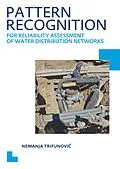This study investigates the patterns that describe reliability of water distribution networks focusing to the node connectivity, energy balance, and economics of construction, operation and maintenance. A number of measures to evaluate the network resilience has been developed and assessed to arrive at more accurate diagnostics of regular and irreg
Autorentext
Nemanja. Trifunovic is Associate Professor of Water Supply at UNESCO-IHE Institute for Water Education. He is specialist in the field of Water Transport and Distribution in general and in application of computer models in urban distribution networks in particular. Apart from lecturing assignments, he has been involved in guidance of MSc research as well as in organising various forms of training in his field, including the development of online learning modules in water distribution that are running since 2005. The major research interests are related to the hydraulic operation and asset management of water networks, namely the reliability assessment, intermittent supply, non-revenue water and water safety planning. In period 1995-1998 and 2001-2003 he was the Programme Director of The Sanitary Engineering Masters programme at UNESCO-IHE. Numerous missions he conducted in Africa, Asia and Middle East include participation in various capacity building projects and educational and training programmes. Since 2001, Mr.Trifunovic has been the Project Director of large capacity building projects conducted at universities in Ghana, and since 2010 in South Africa.
Inhalt
1 INTRODUCTION 1.1 Water Distribution Models 1.2 Limits and Risks 1.3 Reliability 1.4 Aim of the Study 1.5 Structure of the Thesis 1.6 Acknowledgements 2 THEORETICAL AND CONCEPTUAL FRAMEWORK 2.1 Background 2.2 Reliability Assessment of Water Distribution Networks 2.3 Classification of Methods for Reliability Assessment 2.4 Modelling Failures in Water Distribution Systems 2.5 Simulation Approaches Using Demand-Driven Models 2.6 Main Gaps in Networks Reliability Analyses 2.7 Research Objectives and Scope 2.8 Research Methodology 3 EMITTER BASED ALGORITHM FOR PRESSURE-DRIVEN DEMAND CALCULATIONS OF WATER DISTRIBUTION NETWORKS 3.1 Introduction 3.2 Pressure-Driven Demand Concept 3.3 Emitter Performance under Extreme Topographic Conditions 3.4 Emitter Based PDD Algorithm 43.5 Test Case 3.6 Calculation of Available Demand 3.7 Networks of Combined Configuration 3.8 Conclusions 4 SPATIAL NETWORK GENERATION TOOL FOR PERFORMANCE ANALYSIS OF WATER DISTRIBUTION NETWORKS 4.1 Introduction 4.2 Graph Theory Terminology and Application 4.3 Generation Theory Concepts Used in Network Generation Algorithm 4.4 Generation Process 4.5 Algorithm of Network Generation Tool 4.6 Network Generation Tool in Use 4.7 Test Cases 4.8 Conclusions 5 HYDRAULIC RELIABILITY DIAGRAM AND NETWORK BUFFER INDEX AS INDICATORS OF WATER DISTRIBUTION NETWORK RESILIENCE 5.1 Introduction 5.2 Hydraulic Reliability Diagram 5.3 Relation between Pipe Flow and Loss of Demand 5.4 Hydraulics of Looped Networks under Stress Conditions 5.5 Network Buffer Index 5.6 Comparison of NBI with the Resilience Indices 5.7 Test Network from Literature 5.8 Case: Water Distribution Network Amsterdam North 5.9 Conclusions 6 IMPACTS OF NODE CONNECTIVITY ON RELIABILITY OF WATER DISTRIBUTION NETWORKS 6.1 Introduction 6.2 Tools for Analysis of Network Connectivity 6.3 Geometric Properties as Indicators of Network Reliability 6.4 Analysis of Network Connectivity Based on Graph Theory 6.4.5 Closeness Centrality 6.4.6 Clustering Coefficient 16.5 Simulation Runs, Case 16 Networks 6.6 Simulation Runs, Case 30 Networks 6.7 Simulation Runs, Case Three Clusters of 10 Networks 6.8 Simulation Runs, Case NGT Networks 6.9 Statistical Analysis 6.10 Conclusions 7 DIAGNOSTICS OF REGULAR PERFORMANCE OF WATER DISTRIBUTION NETWORKS AND ITS RELATION TO THE NETWORK RELIABILITY 7.1 Introduction 7.2 Hydraulic Properties as Indicators of Network Reliability 7.3 Simulation Runs 7.4 Correlation of Reliability Measures with Demand Growth 7.5 Correlation of Reliability Measures with Diameter Increase 7.6 Network Properties and Their Relation to Demand Loss 7.7 Pipe Flows and Volumes as Indicators of Network Reliability 7.8 Conclusions 8 ECONOMIC ASPECTS OF DECISION MAKING IN RELIABILITY ASSESSMENT OF WATER DISTRIBUTION NETWORKS 8.1 Introduction 8.2 Planning of Costs in Water Distribution 8.3 Components of Most Economic Design 8.4 Design Alternatives Based on Topography 8.5 Hydraulic Reliability and its Costs 8.6 Hydraulic Simulations and Reliability Assessment 8.7 Performance of Optimised Networks 8.8 Reliability Patterns of Networks with Reduced Resistance 8.9 Economic Aspects of Network Reliability 8.10 Conclusions 9 DECISION SUPPORT TOOL FOR DESIGN AND RELIABILITY ASSESSMENT OF WATER DISTRIBUTION NETWORKS 9.1 Introduction 9.2 Design Parameters and Reliability Consideration 9.3 Network Design and Reliability Assessment Tool 9.4 Case Study 9.5 Results and Discussions 9.6 Conclusions 10 CONCLUSIONS 10.1 Research Summary 10.2 Conclusions in Response to Research Questions and Hypotheses 10.3 Recommendations for Further Research
